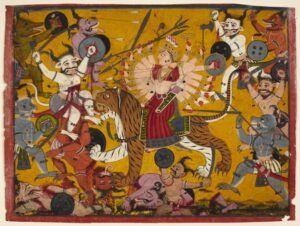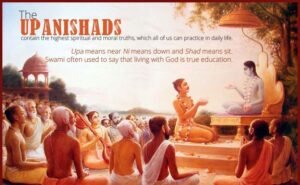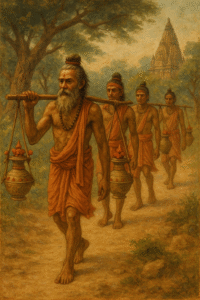The Bhagavad Gita
The Bhagavad Gita, often referred to simply as the Gita, is one of the most revered texts in Hinduism and is considered a spiritual and philosophical guide for millions of people around the world. Composed in Sanskrit and consisting of 700 verses, the Gita is a dialogue between Prince Arjuna and the god Krishna, who serves as his charioteer. This conversation takes place on the battlefield of Kurukshetra, just before the start of a great war.
The Gita addresses profound questions about duty, righteousness, and the nature of reality, offering insights that are relevant not only to the context of ancient India but also to the challenges of modern life. This article explores the key themes, teachings, and philosophical insights of the Bhagavad Gita, highlighting its significance in Hindu spirituality and ethics.
Historical and Cultural Context
The Bhagavad Gita is part of the larger epic, the Mahabharata, which tells the story of a dynastic struggle for the throne of Hastinapura. The Gita is situated in the Bhishma Parva (Book of Bhishma) and is set on the eve of the great battle between the Pandavas and the Kauravas.
At the beginning of the Gita, Arjuna, the warrior prince, is filled with doubt and moral confusion about fighting in the battle. He is troubled by the prospect of killing his own relatives, teachers, and friends, and questions whether it is righteous to engage in such a conflict. In response, Krishna offers Arjuna guidance, addressing his concerns and revealing profound spiritual truths.

This dialogue serves as a microcosm of the larger struggle within the Mahabharata, reflecting the eternal conflict between good and evil, duty and desire, and the self and the universe.
Key Themes and Teachings
The Bhagavad Gita presents several key themes and teachings that have become central to Hindu spirituality and ethics:
- Dharma: One of the core teachings of the Gita is the concept of Dharma, which refers to the moral and ethical duties that each individual must follow. Krishna advises Arjuna to perform his duty as a warrior without attachment to the results, emphasizing that one’s Dharma is determined by their role in society and their stage of life. The Gita teaches that upholding one’s Dharma is essential for maintaining the order and harmony of the universe.
- Karma Yoga: The Gita introduces the concept of Karma Yoga, the path of selfless action. Krishna instructs Arjuna to perform his duties without attachment to the fruits of his actions. This form of yoga teaches that one should act in accordance with their Dharma, dedicating the results to the divine. Karma Yoga is a practical guide for living a life of purpose and integrity.
- Bhakti Yoga: Bhakti Yoga, the path of devotion, is another central teaching of the Gita. Krishna emphasizes the importance of devotion to God as a means of achieving spiritual liberation. Bhakti involves surrendering oneself to the divine, cultivating love and devotion, and seeing God in all beings. This path is accessible to all, regardless of one’s social or religious background.
- Jnana Yoga: The Gita also discusses Jnana Yoga, the path of knowledge. This involves the pursuit of spiritual wisdom and the realization of the true nature of the self (Atman) and its relationship with the ultimate reality (Brahman). Jnana Yoga is often associated with the study of sacred texts, meditation, and contemplation, leading to the realization that the self is eternal and beyond the physical body.
Philosophical Insights
The Bhagavad Gita offers profound philosophical insights into the nature of the self, the universe, and the divine:
- The Nature of the Self (Atman): Krishna explains that the true self, or Atman, is eternal and indestructible. The body may perish, but the soul remains, passing through different lives in the cycle of Samsara (reincarnation). Understanding this distinction between the physical body and the eternal self is key to achieving liberation (Moksha).
- The Concept of God (Brahman) and the Universe: The Gita presents a complex view of God, where Krishna reveals himself as the supreme reality (Brahman) that pervades the entire universe. He explains that all beings and things are manifestations of this divine reality. This understanding of God as both immanent and transcendent is central to Hindu theology.
- Free Will and Destiny: The Gita explores the interplay between free will and destiny. While it emphasizes the importance of making righteous choices and following one’s Dharma, it also acknowledges the role of divine will in shaping the course of events. Krishna’s teachings suggest that while individuals have the freedom to choose their actions, the outcomes are ultimately in the hands of the divine.
Relevance in Modern Life
The teachings of the Bhagavad Gita continue to resonate with people from all walks of life, offering guidance on ethical conduct, spiritual practice, and the pursuit of a meaningful life. In today’s fast-paced world, where individuals often struggle with stress, anxiety, and moral dilemmas, the Gita’s emphasis on detachment, selfless action, and devotion provides a valuable framework for living with purpose and peace.
The Gita’s teachings on Karma Yoga, in particular, are applicable in various aspects of life, from professional endeavors to personal relationships. By encouraging individuals to perform their duties without attachment to the results, the Gita offers a way to navigate the complexities of modern life with equanimity and integrity.
The Bhagavad Gita is more than just a religious scripture; it is a timeless guide to living a life of purpose, wisdom, and spiritual fulfillment. Its teachings on Dharma, Karma, Bhakti, and Jnana provide a comprehensive framework for understanding the complexities of existence and the path to liberation. As one of the most important texts in Hinduism, the Gita’s influence extends far beyond its cultural and historical context, offering insights that are as relevant today as they were thousands of years ago.






